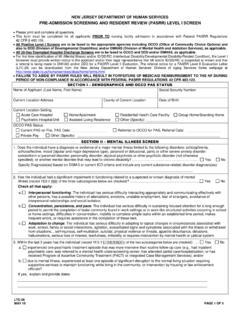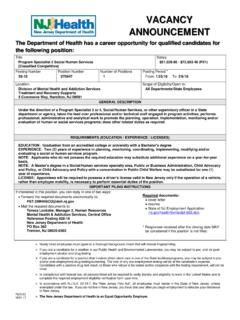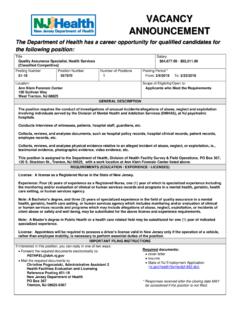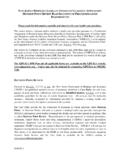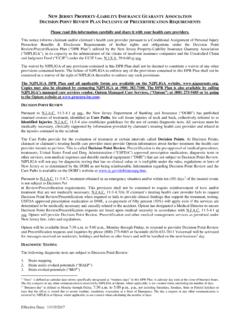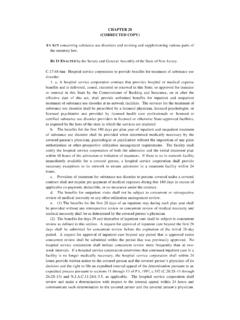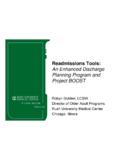Transcription of New York City Municipal Separate Storm Sewer …
1 New York city Municipal Separate Storm Sewer (MS4) Permit (SPDES Number NY-0287890). The city of New York's Draft Procedures for No Net Increase Pollutant Load Analysis Submitted Pursuant to Permit Part II. B. 1. February 1, 2018. The New York State Department of Environmental Conservation's ( NYSDEC ) State Pollutant Discharge Elimination System ( SPDES ) Permit Number NY-0287890, effective August 1, 2015 ( Permit ), requires the city of New York ( city ) to submit a draft of the procedures that will be used to ensure Stormwater Pollution Prevention Plans (SWPPPs). submitted as part of the city 's construction/post-construction program contain adequate control measures to meet the no net increase requirement in Permit Part , including but not limited to pollutant specific land use coefficients and pollutant removal efficiencies for the different stormwater management practices that will be required for developers as part of the pollutant load analysis. The Permit specifies that non-negligible land use changes are those that involve one or more acres of disturbance and an increase in imperviousness.
2 Where a proposed project involves a non-negligible change in land use within the MS4 area draining to an impaired water, the Department of Environmental Protection (DEP) will require structural and non-structural control measures. The SWPPP will require a pollutant load analysis that includes a narrative to demonstrate an understanding of the pollutant of concern, its potential sources and how the selected structural and nonstructural practices will reduce the potential for the pollutant to enter impaired waters. Where appropriate, DEP will require the analysis to include calculations that demonstrate the selected practices will be effective in reducing the pollutant load to pre-project levels. The impaired waters list included as Appendix 2 in the Permit identifies the pollutants of concern as Floatables, Phosphorus, Pathogens and Nitrogen. Part of the Permit provides, Post construction treatment practices designed, constructed and installed in accordance with the New York State (NYS) Stormwater Management Design Manual (January 2015) will satisfy the no net increase requirement for discharges to waterbodies impaired for Floatables, except when the floatables-impaired waterbodies have other impairments.
3 Part provides, For Phosphorus limited waterbodies, compliance with Chapter 10 of the NYS Stormwater Management Design Manual (January 2015) will satisfy the no net increase requirement. In order to satisfy the no net increase requirement for Floatables and Phosphorus, the city 's program will require SWPPPs for projects in MS4 areas that discharge to waters impaired for these pollutants of concern to comply with the cited provisions of the NYS. Stormwater Management Design Manual. For projects in MS4 areas that discharge to pathogen-impaired waters, the attached position paper, city 's Response to DEC's Guidance on No Net Increase, demonstrates that using a pollutant loading and removal model at a site scale for pathogens is not technically sound or appropriate. To meet the requirement for pathogens, developers will be required to include best management practices (BMPs) to address the specific potential sources of pathogens present at 1. the developed site as part of the operations and maintenance manual for the post construction practices that will be implemented for the development project.
4 Most pathogens found in stormwater runoff are from human and animal fecal matter. To meet the no net increase requirement, SWPPPs will identify the potential sources of human and animal fecal matter and include means to reduce the potential for fecal matter to enter the pathogen-impaired waters through stormwater management practices (SMPs). For example, owners will be required to follow, or provide to tenants, guidance on how to reduce attractive nuisances that encourage animal activity like easily accessible dumpsters or open trash cans with food waste. Projects in MS4 areas that discharge to nitrogen-impaired waters will provide calculations to demonstrate no net increase as part of the SWPPP. Table 1 below shows literature-based values for total nitrogen (TN) event mean concentrations (EMCs). DEP will use the median values from the table as loading coefficients based on land use for no net increase demonstrations. In addition, DEP is conducting a long-term monitoring program in MS4 areas that will look to capture and refine the EMCs for TN.
5 As that work progresses, DEP will update the literature values with actual values, when appropriate. The critical element in determining a non-negligible land use change is an increase in imperviousness when a proposed new development or redevelopment will disturb one acre of soil or more. An increase in imperviousness will increase the runoff volume and pollutants discharged to a receiving waterbody. The loading is the difference between the existing use load and the proposed use load. 2. Table 1: Event Mean Concentrations (EMCs) for Total Nitrogen (TN) from Literature TN- Land Use Based- EMC Summary Literature Reviewed Low- Medium- High-Density Residential Commercial Industrial Vacant Density Density Residential Residential Residential NURP (1983)1 NSQD (2004)2 DC-DDOE Technical Memorandum (2014)3 Baird and Jenning (1996)4 5. Baldys, S. et al (1998) Guerard, P. and Weiss, W. B. (1995)6 LA County Stormwater Monitoring Report (1999)7 8. Harper, (1998) May, D. and Sivkumar, M.
6 (2009)9 Byram River Watershed Management Plan (2012)10 Median (mg/L) Average (mg/L) 1. Smullen et al. (1999). Updating the Nationwide Urban Runoff Quality Database, and EPA (1983). Results of the Nationwide Urban Runoff 2. Pitt, R. et al. (2004). Findings from the National Stormwater Quality 3. District Department of the Environment. (2014). Technical Memorandum: Event Mean Concentrations (EMCs). 4. Baird, C., and M. Jennings. (1996). Characterization of Nonpoint Sources and Loadings to the Corpus Christi Bay National Estuary Program Study Area, Texas Natural Resource Conservation Commission. 5. Baldys, S. et al. (1998). Urban Stormwater Quality, Event-Mean Concentrations, and Estimates of Stormwater Pollutant Loads, Dallas-Fort Worth Area, Texas, 1992-1993. 6. Guerard, P., and Weiss, W. B. (1995). Water Quality of Storm Runoff and Comparison of Procedures for Estimating Storm -Runoff Loads, Volume, Event-Mean Concentrations, and the Mean Load for a Storm for Selected Properties and Constituents for Colorado Springs, Southeastern Colorado, 1992.
7 7. Los Angeles County Stormwater Monitoring Report: 1998-1999 (1999). 8. Harper, H. H. (1998) Stormwater Chemistry and Water Quality. 9. May, D. & Sivakumar, M. (2009). Prediction of nutrient concentrations in urban Storm water. Journal of Environmental Engineering,135 (8), 586-594. 10. Columbia University. (2012). Byram River Watershed Model Development. 3. Table 2 is a list of pollutant removal capabilities by SMP. The SMPs chosen are those that can be implemented on most sites and reduce a minimum of 30% of the nitrogen loading. Developers will be required to implement SMPs to achieve no net increase in nitrogen loadings in MS4 areas that discharge to nitrogen-impaired waters. DEP will develop a stormwater calculator using the TN EMCs and removal rates. The calculator will be available to developers online as part of the NYC Stormwater Design Manual, and will allow them to determine their compliance with the no net increase requirement for nitrogen when preparing SWPPPs. Table 2: Total Nitrogen Removal Rates (Based on Estimated Mass Loading Reductions Annually).
8 Bioretention Rain Porous Green Sand Filter Literature Reviewed Bioretention with garden Pavement Roof (Filtration). Underdrain New Hampshire Stormwater Manual11 20% 60% 40% 65% 60%. New Jersey Stormwater Manual12 30% 50% 30% 30% 35%. 13. Chesapeake Bay Guidance 80% 35% 0%. Norwalk River Watershed Management Plan (2011)14 32% 70% 53% 43%. Chesapeake Bay Program Adopted Effectiveness15 25% 59% 45% 64% 30%. 16. Pennsylvania NPDES 80% 75% 80% 40% 25%. 17. NY Stormwater Manual 40%. Median (mg/L) 30% 65% 43% 54% 40% 25%. Average (mg/L) 37% 66% 42% 53% 40% 25%. 11. New Hampshire Department of Environmental Services (2008). New Hampshire Stormwater Manual. 12. New Jersey Department of Environmental Protection (2004). New Jersey Stormwater Best Management Practices Manual. 13. Maryland Department of Environment. (2009) Maryland's Urban Stormwater Best Management Practices by Era Proposal. 14. Norwalk Watershed. 15. Chesapeake Bay Program. 16. Pennsylvania Department of Environmental Protection.
9 (2016). 17. Center for Watershed Protection. (2015). New York State Stormwater Management Design Manual. 4. To ensure implementation of the no net increase criteria, DEPs SWPPP review checklist will include the items listed in Table 3. For the purposes of this document, the comment column illustrates the basis for comments on each topic. Table 3: SWPPP Review Checklist Items Item/Reference Description Y/N/NA Comment No Net Increase Is the project in an impaired This requirement is in Requirement watershed? addition to existing Water If yes, identify the impairment Quality Volume (WQv). and check for a narrative criteria per NYS Stormwater analysis. Design Manual requirements for new development and redevelopment Impaired for Does the SMP comply with Chapter 10 should be Phosphorus Chapter 10 of NYS Design referenced first as this criteria Manual? would impact WQv calculations Impaired for Does the analysis include Calculator to be provided by Nitrogen calculations demonstrating No DEP should be used Net Increase and are they correct?
10 Impaired for Does the operations and Part of draft 2017. Pathogens maintenance manual include MS4 General Permit should methods to reduce the sources be referenced of pathogens? Impaired for Does the SMP meet NYS SMPs selected and sized to Floatables Design Manual? manage/treat WQv and/or no net increase requirements should comply 5. city 's Response to DEC's Guidance on No Net Increase New York city Municipal Separate Storm Sewer (MS4) Permit (SPDES Number NY-0287890). February 1, 2018. A. Background: On October 23, 2017, DEC provided the following guidance for the No Net Increase requirement in the New York city MS4 permit for SWPPP reviews: Each of the four POCs that are listed in the NYC MS4 permit as causing an impairment to NYC. waterbodies (floatables, phosphorus, pathogens, nitrogen) can meet the No Net Increase requirement for non-negligible land use changes in areas draining to impaired waterbodies in the following manner: Floatables - by designing and implementing post construction treatment practices that are in conformance with NYS Storm Water Management Design Manual.










